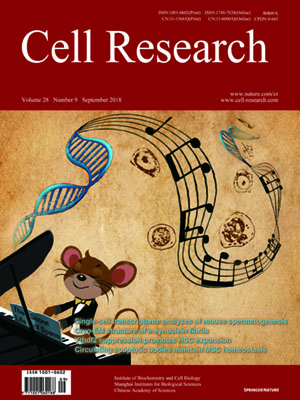
Volume 28, No 9, Sep 2018
ISSN: 1001-0602
EISSN: 1748-7838 2018
impact factor 17.848*
(Clarivate Analytics, 2019)
Volume 28 Issue 9, September 2018: 897-903
ORIGINAL ARTICLES
Amyloid fibril structure of α-synuclein determined by cryo-electron microscopy
Yaowang Li 1, Chunyu Zhao 2,3, Feng Luo 2,3, Zhenying Liu 2,3, Xinrui Gui 2,3, Zhipu Luo 4, Xiang Zhang 2,3, Dan Li 5, Cong Liu 2 and Xueming Li 1
1 Key Laboratory of Protein Sciences (Tsinghua University), Ministry of Education, School of Life Sciences, Tsinghua University, Beijing 100084, China; 2 Interdisciplinary Research Center on Biology and Chemistry, Shanghai Institute of Organic Chemistry, Chinese Academy of Sciences, Shanghai 201210, China; 3 University of Chinese Academy of Sciences, Beijing 100049, China; 4 Institute of Molecular Enzymology, Soochow University, Suzhou, Jiangsu 215123, China and 5Bio-X Institutes, Shanghai Jiao Tong University, Shanghai 200030, China
Correspondence: Dan Li (lidan2017@sjtu.edu.cn) or Cong Liu (liulab@sioc.ac.cn) or Xueming Li (lixueming@tsinghua.edu.cn)These authors contributed equally: Yaowang Li, Chunyu Zhao, Feng Luo
α-Synuclein (α-syn) amyloid fibrils are the major component of Lewy bodies, which are the pathological hallmark of Parkinson’s disease (PD) and other synucleinopathies. High-resolution structure of α-syn fibril is important for understanding its assembly and pathological mechanism. Here, we determined a fibril structure of full-length α-syn (1–140) at the resolution of 3.07 Å by cryo-electron microscopy (cryo-EM). The fibrils are cytotoxic, and transmissible to induce endogenous α-syn aggregation in primary neurons. Based on the reconstructed cryo-EM density map, we were able to unambiguously build the fibril structure comprising residues 37–99. The α-syn amyloid fibril structure shows two protofilaments intertwining along an approximate 21 screw axis into a left-handed helix. Each protofilament features a Greek key-like topology. Remarkably, five out of the six early-onset PD familial mutations are located at the dimer interface of the fibril (H50Q, G51D, and A53T/E) or involved in the stabilization of the protofilament (E46K). Furthermore, these PD mutations lead to the formation of fibrils with polymorphic structures distinct from that of the wild-type. Our study provides molecular insight into the fibrillar assembly of α-syn at the atomic level and sheds light on the molecular pathogenesis caused by familial PD mutations of α-syn.
https://doi.org/10.1038/s41422-018-0075-x
FULL TEXT | PDF
Browse 1086


